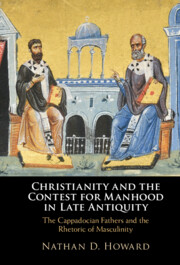Refine search
Actions for selected content:
60620 results in Classical studies (general)
Abbreviations
-
- Book:
- The Lives of Ancient Villages
- Published online:
- 28 October 2022
- Print publication:
- 17 November 2022, pp xiii-xvii
-
- Chapter
- Export citation
Tables
-
- Book:
- The Lives of Ancient Villages
- Published online:
- 28 October 2022
- Print publication:
- 17 November 2022, pp x-x
-
- Chapter
- Export citation
9 - Village Society
-
- Book:
- The Lives of Ancient Villages
- Published online:
- 28 October 2022
- Print publication:
- 17 November 2022, pp 284-318
-
- Chapter
- Export citation
Preface
-
- Book:
- The Lives of Ancient Villages
- Published online:
- 28 October 2022
- Print publication:
- 17 November 2022, pp xi-xii
-
- Chapter
- Export citation
7 - Beyond the Family
-
- Book:
- The Lives of Ancient Villages
- Published online:
- 28 October 2022
- Print publication:
- 17 November 2022, pp 216-240
-
- Chapter
- Export citation
3 - Demography
-
- Book:
- The Lives of Ancient Villages
- Published online:
- 28 October 2022
- Print publication:
- 17 November 2022, pp 72-102
-
- Chapter
- Export citation
2 - Commemorative Cultures
-
- Book:
- The Lives of Ancient Villages
- Published online:
- 28 October 2022
- Print publication:
- 17 November 2022, pp 25-71
-
- Chapter
- Export citation
Figures
-
- Book:
- The Lives of Ancient Villages
- Published online:
- 28 October 2022
- Print publication:
- 17 November 2022, pp vi-ix
-
- Chapter
- Export citation
4 - Kinship Terminology
-
- Book:
- The Lives of Ancient Villages
- Published online:
- 28 October 2022
- Print publication:
- 17 November 2022, pp 103-145
-
- Chapter
- Export citation
Index
-
- Book:
- The Lives of Ancient Villages
- Published online:
- 28 October 2022
- Print publication:
- 17 November 2022, pp 378-382
-
- Chapter
- Export citation
8 - Rural Sanctuaries
-
- Book:
- The Lives of Ancient Villages
- Published online:
- 28 October 2022
- Print publication:
- 17 November 2022, pp 241-283
-
- Chapter
- Export citation
References
-
- Book:
- The Lives of Ancient Villages
- Published online:
- 28 October 2022
- Print publication:
- 17 November 2022, pp 357-377
-
- Chapter
- Export citation
maps
-
- Book:
- The Lives of Ancient Villages
- Published online:
- 28 October 2022
- Print publication:
- 17 November 2022, pp xviii-xx
-
- Chapter
- Export citation
THE STRAIT OF MESSINA THEN AND NOW - (M.B.) Carbone Geographies of Myth and Places of Identity. The Strait of Scylla and Charybdis in the Modern Imagination. Pp. xvi + 256, ills, map. London and New York: Bloomsbury Academic, 2022. Cased, £85, US$115. ISBN: 978-1-350-11818-8.
-
- Journal:
- The Classical Review / Volume 73 / Issue 1 / April 2023
- Published online by Cambridge University Press:
- 16 November 2022, pp. 333-335
- Print publication:
- April 2023
-
- Article
- Export citation
ASYNDETON IN LATIN - (J.N.) Adams Asyndeton and its Interpretation in Latin Literature. History, Patterns, Textual Criticism. Pp. xxx + 751, ill. Cambridge: Cambridge University Press, 2021. Cased, £130. ISBN: 978-1-108-83785-9.
-
- Journal:
- The Classical Review / Volume 73 / Issue 1 / April 2023
- Published online by Cambridge University Press:
- 16 November 2022, pp. 114-116
- Print publication:
- April 2023
-
- Article
- Export citation
THE ROMANS IN BRITAIN - (R.) Hingley Conquering the Ocean. The Roman Invasion of Britain. Pp. xiv + 312, ills, maps. New York: Oxford University Press, 2022. Cased, £22.99, US$29.95. ISBN: 978-0-19-093741-6.
-
- Journal:
- The Classical Review / Volume 73 / Issue 1 / April 2023
- Published online by Cambridge University Press:
- 16 November 2022, pp. 296-298
- Print publication:
- April 2023
-
- Article
- Export citation
WOMEN AND HOMER - (F.) Cox, (E.) Theodorakopoulos (edd.) Homer's Daughters. Women's Responses to Homer in the Twentieth Century and Beyond. Pp. xviii + 341, ills. Oxford: Oxford University Press, 2019. Cased, £75, US$100. ISBN: 978-0-19-880258-7.
-
- Journal:
- The Classical Review / Volume 73 / Issue 1 / April 2023
- Published online by Cambridge University Press:
- 16 November 2022, pp. 34-37
- Print publication:
- April 2023
-
- Article
- Export citation
ASPECTS OF GREEK POETRY - (E.) Bowie Essays on Ancient Greek Literature and Culture. Volume 1: Greek Poetry before 400 bc. Pp. xviii + 866, ill. Cambridge: Cambridge University Press, 2022. Cased, £135, US$175. ISBN: 978-1-107-05808-8.
-
- Journal:
- The Classical Review / Volume 73 / Issue 1 / April 2023
- Published online by Cambridge University Press:
- 16 November 2022, pp. 37-39
- Print publication:
- April 2023
-
- Article
- Export citation

Christianity and the Contest for Manhood in Late Antiquity
- The Cappadocian Fathers and the Rhetoric of Masculinity
-
- Published online:
- 10 November 2022
- Print publication:
- 24 November 2022
ROMAN REPRESENTATIONS OF HISTORY AND MYTH - (A.) Berlan-Bajard Images, spectacles et pouvoir à Rome. Les scènes historiques et mythologiques dans les munera. (Scripta Antiqua 123.) Pp. 345, b/w & colour ills. Bordeaux: Ausonius, 2019. Paper, €25. ISBN: 978-2-35613-252-9.
-
- Journal:
- The Classical Review / Volume 73 / Issue 1 / April 2023
- Published online by Cambridge University Press:
- 09 November 2022, pp. 226-228
- Print publication:
- April 2023
-
- Article
- Export citation
